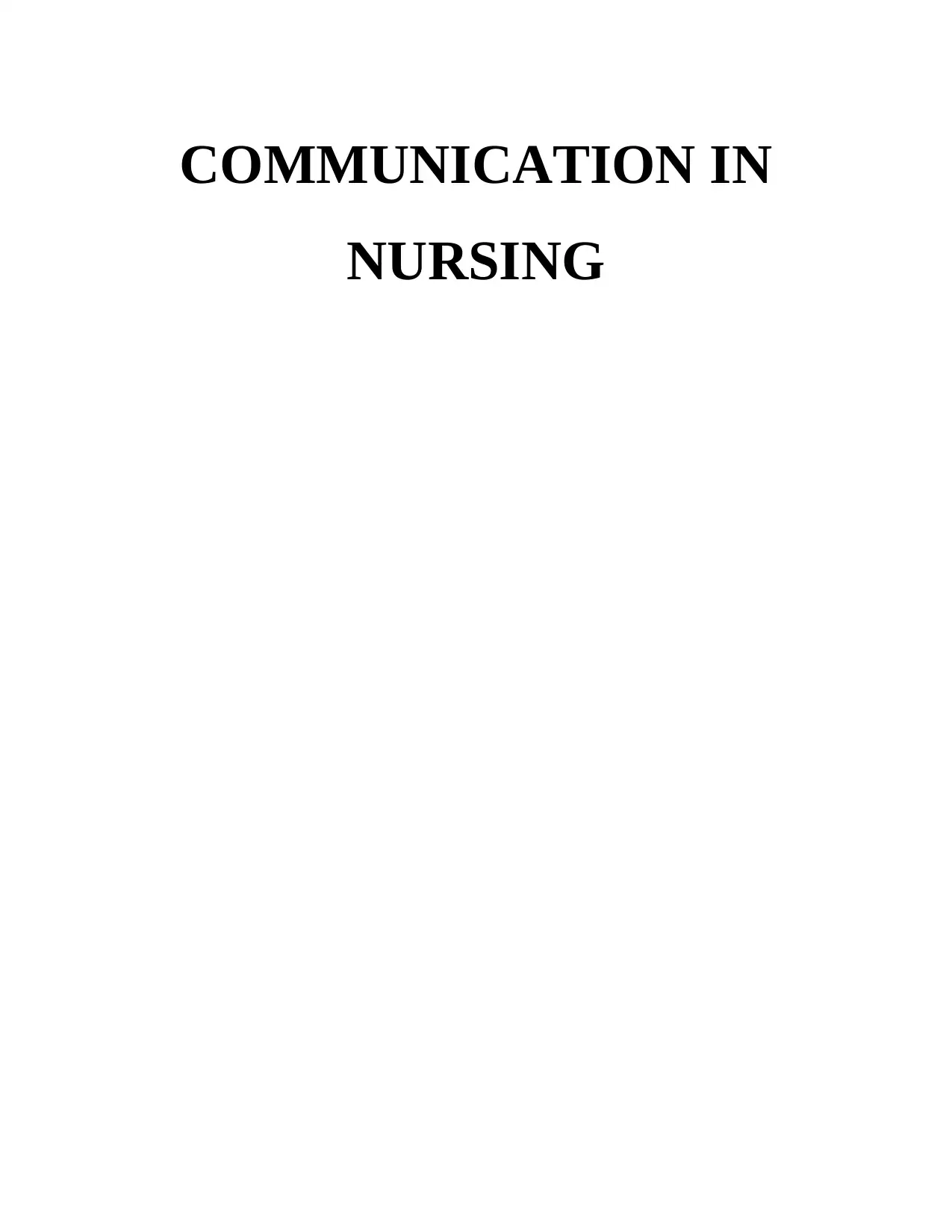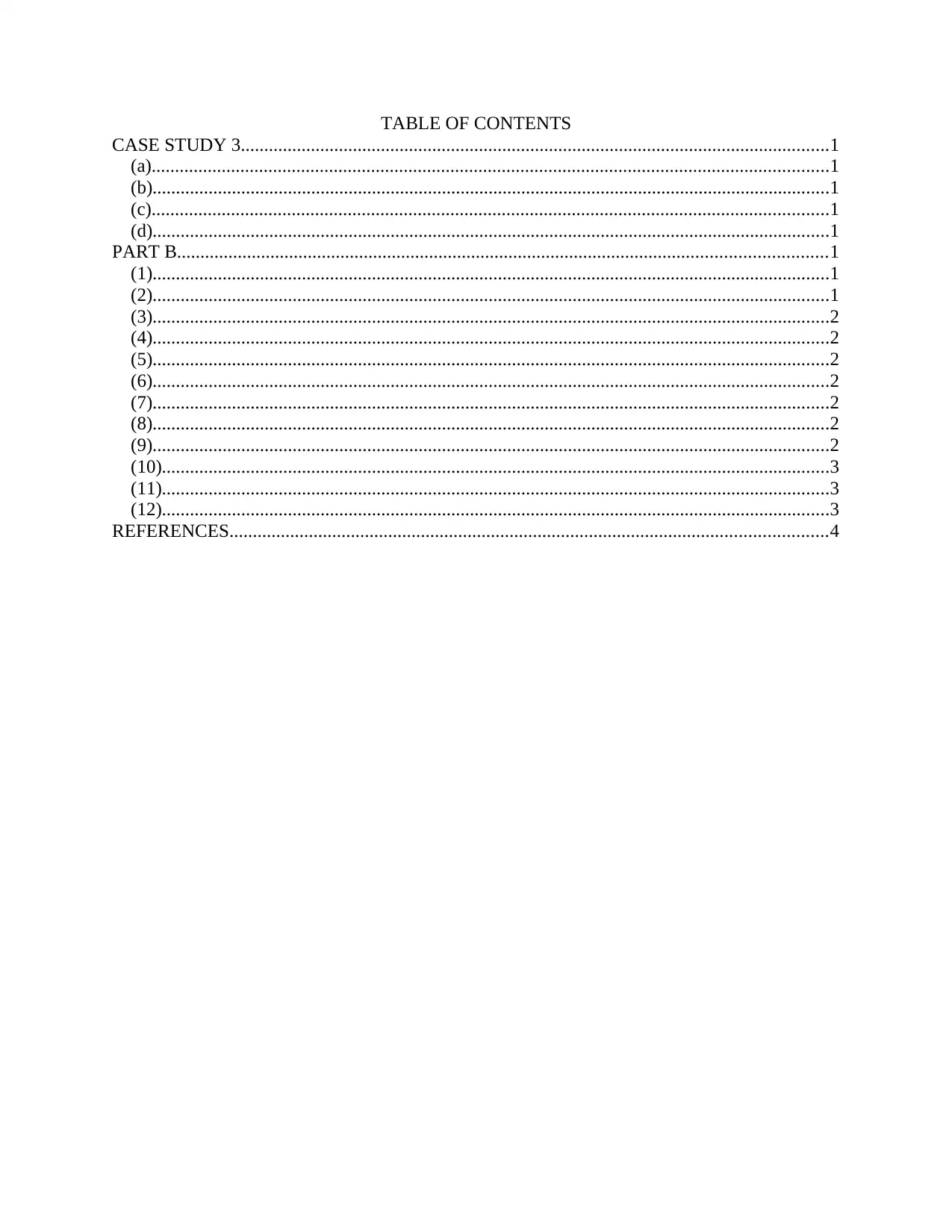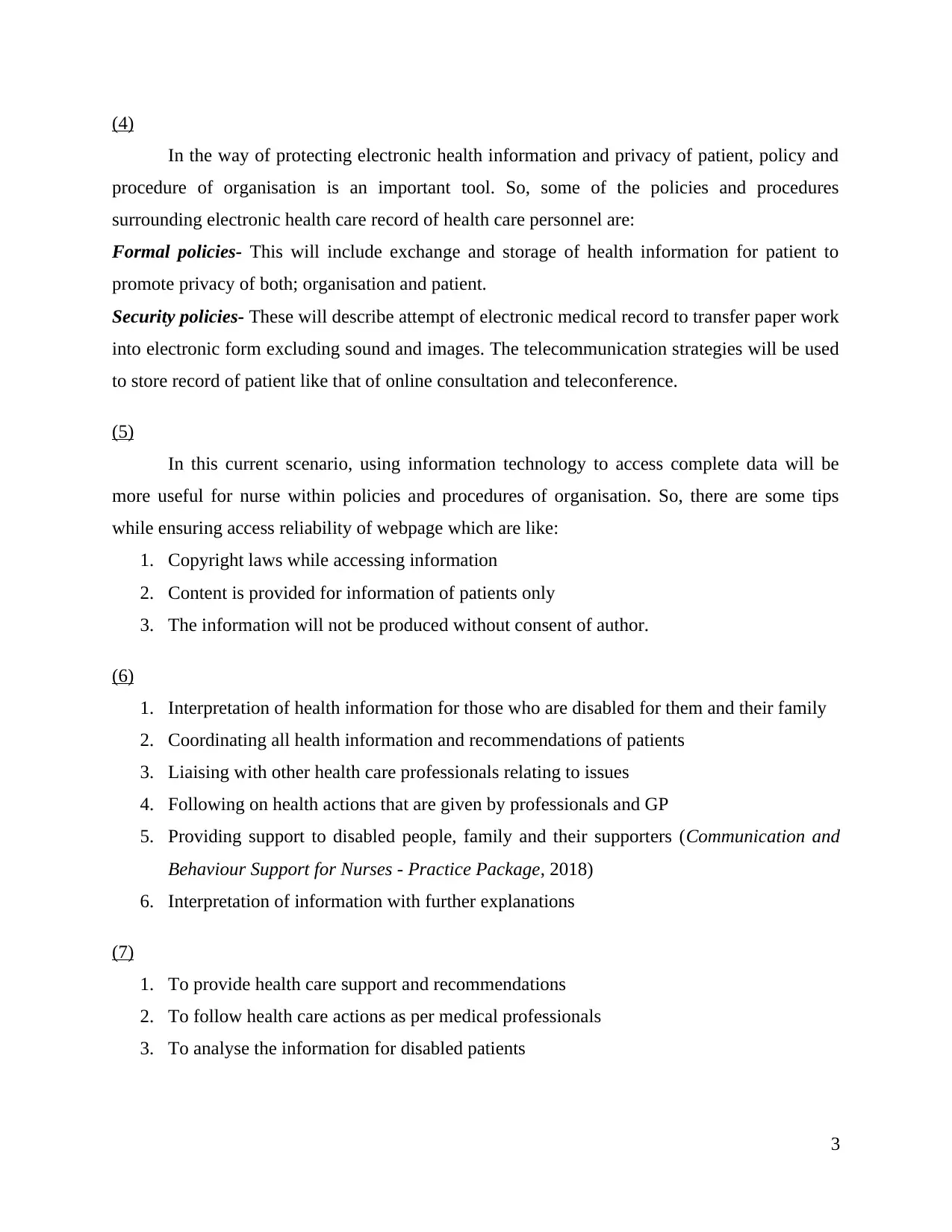Communication Strategies in Nursing: Analysis of Case Study 3 Report
VerifiedAdded on 2020/10/05
|7
|1292
|235
Report
AI Summary
This report presents an analysis of a nursing case study focusing on communication strategies in healthcare settings. The case study explores effective communication techniques, including the importance of clarity, completeness, conciseness, courtesy, cohesion, and correctness. It delves into de-escalation strategies, particularly the use of apologies, and emphasizes the significance of timely debriefing to mitigate psychological harm and improve patient interactions. The report also addresses strategies for receiving feedback from supervisors and outlines the Communication and Behaviour Support for Nurse Practice Package, highlighting its domains, benefits, and the role of information technology in accessing patient data. Furthermore, it covers communication strategies for group discussions, meetings, and providing balanced feedback using the sandwich method, alongside the importance of appropriate language and respectful manners. References from books and journals are included to support the analysis.

COMMUNICATION IN
NURSING
NURSING
Paraphrase This Document
Need a fresh take? Get an instant paraphrase of this document with our AI Paraphraser

TABLE OF CONTENTS
CASE STUDY 3..............................................................................................................................1
(a).................................................................................................................................................1
(b).................................................................................................................................................1
(c).................................................................................................................................................1
(d).................................................................................................................................................1
PART B...........................................................................................................................................1
(1).................................................................................................................................................1
(2).................................................................................................................................................1
(3).................................................................................................................................................2
(4).................................................................................................................................................2
(5).................................................................................................................................................2
(6).................................................................................................................................................2
(7).................................................................................................................................................2
(8).................................................................................................................................................2
(9).................................................................................................................................................2
(10)...............................................................................................................................................3
(11)...............................................................................................................................................3
(12)...............................................................................................................................................3
REFERENCES................................................................................................................................4
CASE STUDY 3..............................................................................................................................1
(a).................................................................................................................................................1
(b).................................................................................................................................................1
(c).................................................................................................................................................1
(d).................................................................................................................................................1
PART B...........................................................................................................................................1
(1).................................................................................................................................................1
(2).................................................................................................................................................1
(3).................................................................................................................................................2
(4).................................................................................................................................................2
(5).................................................................................................................................................2
(6).................................................................................................................................................2
(7).................................................................................................................................................2
(8).................................................................................................................................................2
(9).................................................................................................................................................2
(10)...............................................................................................................................................3
(11)...............................................................................................................................................3
(12)...............................................................................................................................................3
REFERENCES................................................................................................................................4

CASE STUDY 3
(a)
1. Clear- Nurse and other practitioners must be clear in their communication
2. Complete- The medication of David should be complete in all senses.
3. Concise- It must be precise and short so that David could understand it.
4. Courteous- Nurse and doctors must be polite with him as he is aggressive.
5. Cohesive- The complete information given to David should be constant.
6. Correct- Communication must also be correct in all aspects.
(b)
De-escalation strategy would refer to the behaviour that will help in escaping situation of
struggle which is also a correct approach in resolution of conflicts. Apologise will be the best de-
escalation strategy in this current situation where David is becoming aggressive; both verbally
and physically (Riley, 2015). Apologise for the most genuine reason in case of David will help
nurse or other practitioner to calm down him in the best possible way.
(c)
The timely debriefing within health and social care will be very much helpful. It will
enhance the ability of nurse to deal with events like that of death or serious injury. Debriefing
process will surely decrease all probabilities of various kinds of psychological harm like
including what was situation all about, information reviewed thereafter, misconceptions and then
valid conclusion drawn out. Within this current situation, when David becomes both verbally and
physically aggressive, debriefing would be the most essential so that nurse could deal with all
what is happening (Kourkouta and Papathanasiou, 2014). Complete information which will be
used by nurse to debrief David will be helping them to prevent further misshaping of events like
misbehaving and abusing as well.
(d)
In this situation, supervisor provided the feedback regarding how to handle David when
he is becoming physically and verbally violent with doctors and nurses. So, in this order, there
are some strategies to effectively receive feedback from my supervisors which are given as
below:
1
(a)
1. Clear- Nurse and other practitioners must be clear in their communication
2. Complete- The medication of David should be complete in all senses.
3. Concise- It must be precise and short so that David could understand it.
4. Courteous- Nurse and doctors must be polite with him as he is aggressive.
5. Cohesive- The complete information given to David should be constant.
6. Correct- Communication must also be correct in all aspects.
(b)
De-escalation strategy would refer to the behaviour that will help in escaping situation of
struggle which is also a correct approach in resolution of conflicts. Apologise will be the best de-
escalation strategy in this current situation where David is becoming aggressive; both verbally
and physically (Riley, 2015). Apologise for the most genuine reason in case of David will help
nurse or other practitioner to calm down him in the best possible way.
(c)
The timely debriefing within health and social care will be very much helpful. It will
enhance the ability of nurse to deal with events like that of death or serious injury. Debriefing
process will surely decrease all probabilities of various kinds of psychological harm like
including what was situation all about, information reviewed thereafter, misconceptions and then
valid conclusion drawn out. Within this current situation, when David becomes both verbally and
physically aggressive, debriefing would be the most essential so that nurse could deal with all
what is happening (Kourkouta and Papathanasiou, 2014). Complete information which will be
used by nurse to debrief David will be helping them to prevent further misshaping of events like
misbehaving and abusing as well.
(d)
In this situation, supervisor provided the feedback regarding how to handle David when
he is becoming physically and verbally violent with doctors and nurses. So, in this order, there
are some strategies to effectively receive feedback from my supervisors which are given as
below:
1
⊘ This is a preview!⊘
Do you want full access?
Subscribe today to unlock all pages.

Trusted by 1+ million students worldwide

1. Not focusing on negative feedback rather than on positive
2. Assuming positive intent
3. Acting immediately
4. Attaining confirmation that message is received
PART B
(1)
The Communication and Behaviour support for nurse practice package was developed by
Clinical innovation and governance in disability and home care for older people department of
family and community service (FACS). This package was developed in order to help those
nurses who are regularly working with patients and their family who are suffering from disability
(Communication and Behaviour Support for Nurses - Practice Package, 2018).
(2)
There are domains of practice into standard for communication and behaviour support for
nurse practice package like that of:
1. Working with people suffering from complex and chronic health care need
2. Meal time management for nurse
3. Person centred assessment and development of health care plan
(3)
Communication and behaviour support will be guiding nurse at the time of working with
disabled people to promote efficient and best practice. This will also be outlining principle with
good practice designed to complement with process, procedure and policies of organisation.
After completing this communication and behaviour support for nurse appraisal, there are some
benefits. Knowledge level of interaction like intentional, unintentional and symbolic will be
enhancing capabilities with the development of strategies. Nurse will be then focusing primarily
on person who is suffering from disability and working with them so as to interpret the health
needs.
2
2. Assuming positive intent
3. Acting immediately
4. Attaining confirmation that message is received
PART B
(1)
The Communication and Behaviour support for nurse practice package was developed by
Clinical innovation and governance in disability and home care for older people department of
family and community service (FACS). This package was developed in order to help those
nurses who are regularly working with patients and their family who are suffering from disability
(Communication and Behaviour Support for Nurses - Practice Package, 2018).
(2)
There are domains of practice into standard for communication and behaviour support for
nurse practice package like that of:
1. Working with people suffering from complex and chronic health care need
2. Meal time management for nurse
3. Person centred assessment and development of health care plan
(3)
Communication and behaviour support will be guiding nurse at the time of working with
disabled people to promote efficient and best practice. This will also be outlining principle with
good practice designed to complement with process, procedure and policies of organisation.
After completing this communication and behaviour support for nurse appraisal, there are some
benefits. Knowledge level of interaction like intentional, unintentional and symbolic will be
enhancing capabilities with the development of strategies. Nurse will be then focusing primarily
on person who is suffering from disability and working with them so as to interpret the health
needs.
2
Paraphrase This Document
Need a fresh take? Get an instant paraphrase of this document with our AI Paraphraser

(4)
In the way of protecting electronic health information and privacy of patient, policy and
procedure of organisation is an important tool. So, some of the policies and procedures
surrounding electronic health care record of health care personnel are:
Formal policies- This will include exchange and storage of health information for patient to
promote privacy of both; organisation and patient.
Security policies- These will describe attempt of electronic medical record to transfer paper work
into electronic form excluding sound and images. The telecommunication strategies will be used
to store record of patient like that of online consultation and teleconference.
(5)
In this current scenario, using information technology to access complete data will be
more useful for nurse within policies and procedures of organisation. So, there are some tips
while ensuring access reliability of webpage which are like:
1. Copyright laws while accessing information
2. Content is provided for information of patients only
3. The information will not be produced without consent of author.
(6)
1. Interpretation of health information for those who are disabled for them and their family
2. Coordinating all health information and recommendations of patients
3. Liaising with other health care professionals relating to issues
4. Following on health actions that are given by professionals and GP
5. Providing support to disabled people, family and their supporters (Communication and
Behaviour Support for Nurses - Practice Package, 2018)
6. Interpretation of information with further explanations
(7)
1. To provide health care support and recommendations
2. To follow health care actions as per medical professionals
3. To analyse the information for disabled patients
3
In the way of protecting electronic health information and privacy of patient, policy and
procedure of organisation is an important tool. So, some of the policies and procedures
surrounding electronic health care record of health care personnel are:
Formal policies- This will include exchange and storage of health information for patient to
promote privacy of both; organisation and patient.
Security policies- These will describe attempt of electronic medical record to transfer paper work
into electronic form excluding sound and images. The telecommunication strategies will be used
to store record of patient like that of online consultation and teleconference.
(5)
In this current scenario, using information technology to access complete data will be
more useful for nurse within policies and procedures of organisation. So, there are some tips
while ensuring access reliability of webpage which are like:
1. Copyright laws while accessing information
2. Content is provided for information of patients only
3. The information will not be produced without consent of author.
(6)
1. Interpretation of health information for those who are disabled for them and their family
2. Coordinating all health information and recommendations of patients
3. Liaising with other health care professionals relating to issues
4. Following on health actions that are given by professionals and GP
5. Providing support to disabled people, family and their supporters (Communication and
Behaviour Support for Nurses - Practice Package, 2018)
6. Interpretation of information with further explanations
(7)
1. To provide health care support and recommendations
2. To follow health care actions as per medical professionals
3. To analyse the information for disabled patients
3

(8)
The communication strategies that are required in ensuring contribution of participants
with any group discussion with providing and receiving feedback will be as follows:
1. Resolution of conflict
2. Respecting and recording ideas
3. Agreeing listening to each other
(9)
Some points that are needed to be considered by nurse while conducting meetings and
ensuring that meetings are of value or not will be:
1. Communication plans
2. Providing information
3. Behaviour support
4. Receiving messages
5. Review
(10)
Some communication strategies to ensure that whether feedback is in respect with
performance improvement is clear or not will be:
1. Presenting Information Visually
2. Conflict resolution
(11)
The steps of communication techniques while giving balanced feedback will be known as
sandwich method or technique which are like:
1. Starting with positive feedback while praising for something which they have done
2. Then providing constructive criticism with briefing clear and thorough delivery of ideas
3. Afterwards, ending with positive note or complimenting them
(12)
The strategies for appropriate language with respectful manner while giving or receiving
feedback are as follows:
1. Eye contact
2. Body language
4
The communication strategies that are required in ensuring contribution of participants
with any group discussion with providing and receiving feedback will be as follows:
1. Resolution of conflict
2. Respecting and recording ideas
3. Agreeing listening to each other
(9)
Some points that are needed to be considered by nurse while conducting meetings and
ensuring that meetings are of value or not will be:
1. Communication plans
2. Providing information
3. Behaviour support
4. Receiving messages
5. Review
(10)
Some communication strategies to ensure that whether feedback is in respect with
performance improvement is clear or not will be:
1. Presenting Information Visually
2. Conflict resolution
(11)
The steps of communication techniques while giving balanced feedback will be known as
sandwich method or technique which are like:
1. Starting with positive feedback while praising for something which they have done
2. Then providing constructive criticism with briefing clear and thorough delivery of ideas
3. Afterwards, ending with positive note or complimenting them
(12)
The strategies for appropriate language with respectful manner while giving or receiving
feedback are as follows:
1. Eye contact
2. Body language
4
⊘ This is a preview!⊘
Do you want full access?
Subscribe today to unlock all pages.

Trusted by 1+ million students worldwide

REFERENCES
Books and Journals
Kourkouta, L. and Papathanasiou, I.V., 2014. Communication in nursing practice. Materia socio-
medica. 26(1). p.65.
Riley, J.B., 2015. Communication in nursing. Elsevier Health Sciences.
Online
Communication and Behaviour Support for Nurses - Practice Package. 2018. [Online]. Accessed
through: <http://www.adhc.nsw.gov.au/__data/assets/file/0007/301777/Communication-
Behaviour-Support-for-Nurses-Practice-Package.pdf>.
5
Books and Journals
Kourkouta, L. and Papathanasiou, I.V., 2014. Communication in nursing practice. Materia socio-
medica. 26(1). p.65.
Riley, J.B., 2015. Communication in nursing. Elsevier Health Sciences.
Online
Communication and Behaviour Support for Nurses - Practice Package. 2018. [Online]. Accessed
through: <http://www.adhc.nsw.gov.au/__data/assets/file/0007/301777/Communication-
Behaviour-Support-for-Nurses-Practice-Package.pdf>.
5
1 out of 7
Related Documents
Your All-in-One AI-Powered Toolkit for Academic Success.
+13062052269
info@desklib.com
Available 24*7 on WhatsApp / Email
![[object Object]](/_next/static/media/star-bottom.7253800d.svg)
Unlock your academic potential
Copyright © 2020–2025 A2Z Services. All Rights Reserved. Developed and managed by ZUCOL.




